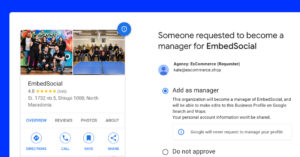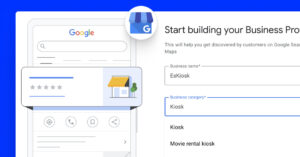Google reviews are more than mere feedback—they have the power to determine any brand’s reputation, search engine ranking, and customer engagement.
Last year, Google introduced changes to its reviews system to make customer feedback more reliable for both consumers and businesses, including frequent updates, a new method for submitting reviews, and an effort to boost the accuracy and usefulness of reviews.
To show you how significant Google reviews can be for the growth of modern businesses in the digital age, we’ve collected the top 15 Google review statistics below.
Why do you need Google reviews to grow your business in 2024?
Google provides one of the most impactful review sites and can influence achieving your key business objectives. Here’s why you should give Google reviews the attention they deserve:
- Improve your digital footprint and SEO – Google loves showcasing businesses that others talk positively about. Many great reviews mean a higher chance of popping up in searches and maps, thus making it easier for new customers to find you. It’s the best way to improve search engine optimization and bring more eyes to your local business;
- Gain your customers’ trust and confidence – before modern consumers decide to spend their money, they want to ensure they buy the right product or service. A solid stack of glowing Google reviews is like saying, “Don’t just take our word for it; see what everyone else is saying!” It’s an effective way to show you’re the real deal;
- Turn prospects into buyers – when potential customers see positive reviews, they’re more likely to take the plunge and buy. Displaying online reviews right on your site can be the nudge they need, acting as a stamp of approval from the wider community;
- Get a goldmine of feedback – every review is a snapshot of what you’re doing right or where you could improve. This feedback is invaluable for tweaking your service, perfecting your products, and making sure you’re hitting the mark with your customers;
- Establish real connections – responding to reviews, both pisitive and negative reviews, shows you’re listening and care about what your customers think, which can turn an unhappy customer into a loyal fan and make happy customers even more enthusiastic about you.
Google reviews are more than just comments; they’re a multifaceted tool that can significantly boost visibility, credibility, customer insights, and ultimately, sales.
Now, let’s back these claims with some relevant online review statistics.

Embed Google Reviews Widget
Automatically collect and embed Google reviews and use AI reviews management tools to unlock your website’s sales potential.
FYI: You can automatically embed Google reviews widget on your website and show authentic user-generated reviews, increasing trust for more sales. Try it now.
Top 15 online review statistics for 2024
The following online review statistics reveal the scope of online reviews and customer feedback’s influence on the success of modern businesses.
1. 95% of customers check product reviews when shopping
Recent surveys from the Medill Spiegel Research Center (SRC)show that
95% of modern consumers check out a product’s or a service’s online reviews during digital transactions.
This statistic is proof of the widespread habit among shoppers to consult and trust online review entries before making purchases.
Businesses need to accept the truth: users read online reviews and base their purchasing decisions on these first-hand opinions and experiences of specific brands and their services. Ultimately, online customer reviews greatly impact consumer behavior, shaping preferences and decisions in the digital marketplace.
2. Google hosts 73% of all online reviews
Google is the king among review sites; Yelp comes second with 6%.
With 73% of all online reviews, Google is the go-to choice for modern consumers looking for social proof before making an online purchase.
This highlights Google’s central importance in the online reputation landscape, reflecting the platform’s widespread usage and trust among consumers for evaluating businesses.
Therefore, companies must put all their focus on establishing a strong presence on Google, since that’s the main platform where they’ll be convincing potential customers to trust them.
3. 53% of customers expect businesses to quickly respond to negative online reviews
Based on recent data from Review Trackers:
53% of the online customers expect modern businesses to address negative reviews within a week of receiving them.
Even more pressing, a third of customers (33%) anticipate a response within three days, highlighting the urgency with which consumers seek resolution or at least recognition of their issues, underscoring the importance of timely feedback.
Despite these expectations, a disconnect remains, as two-thirds (63%) of users report that at least one business has never responded to an online review. This gap underscores a missed opportunity for businesses to engage with their customers, address grievances, and potentially turn detractors into advocates by demonstrating attentive customer service.
4. Positive reviews encourage customers to spend 31% more
It has been reported that customers are willing to spend 31% more on products or services that boast excellent reviews.
This substantial increase in spending underscores the value of positive feedback in shaping consumer perceptions and decisions.
When businesses accumulate positive reviews, they not only enhance their reputation and attract a broader customer base but also boost the perceived value of their offerings.
5. 81% of consumers check Google to evaluate local businesses
Per BrighLocal’s consumer review survey:
Google is the first choice when it comes to checking online reviews for 81% of modern consumers with Facebook (45%) coming second.
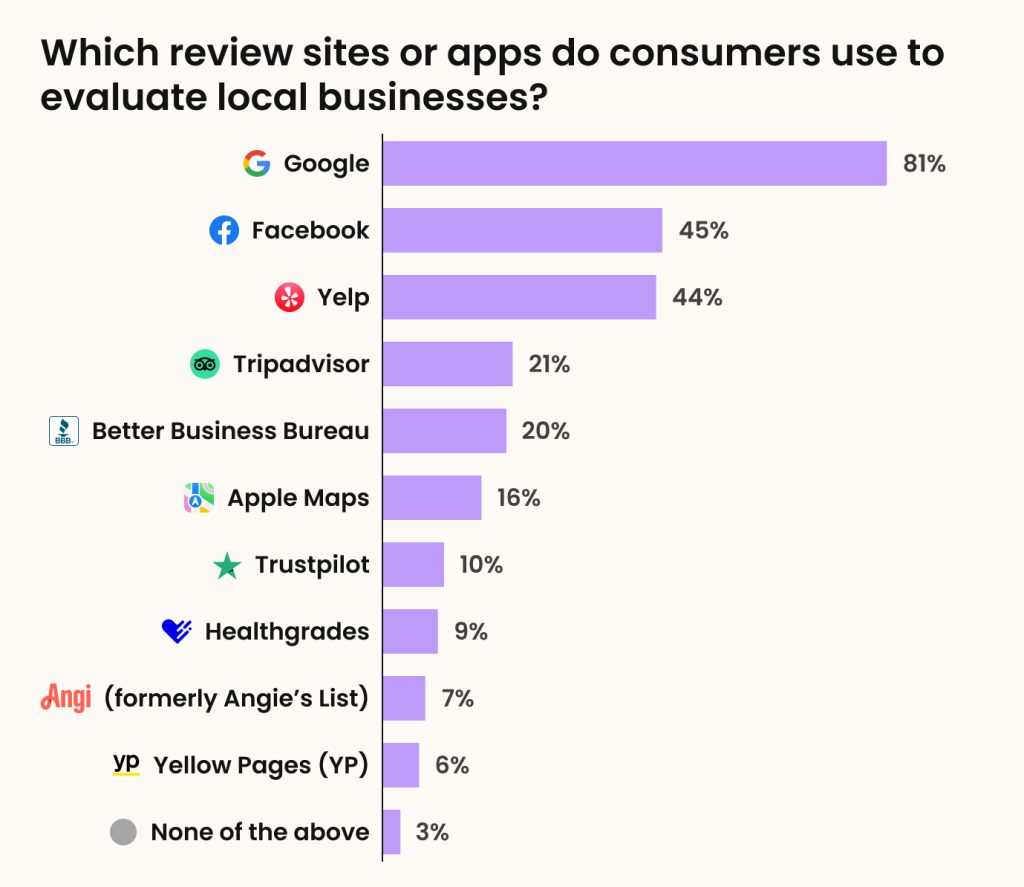
That said, over a third (36%) of consumers check at least 2 sites before making the final purchasing decision. Only 7% are so thorough that they look at 5+ sites.
This reliance on shared experiences emphasizes the need for businesses to monitor and improve their online reputation, highlighting the importance of positive feedback.
6. 34% of the Google reviews are for businesses in the Healthcare industry
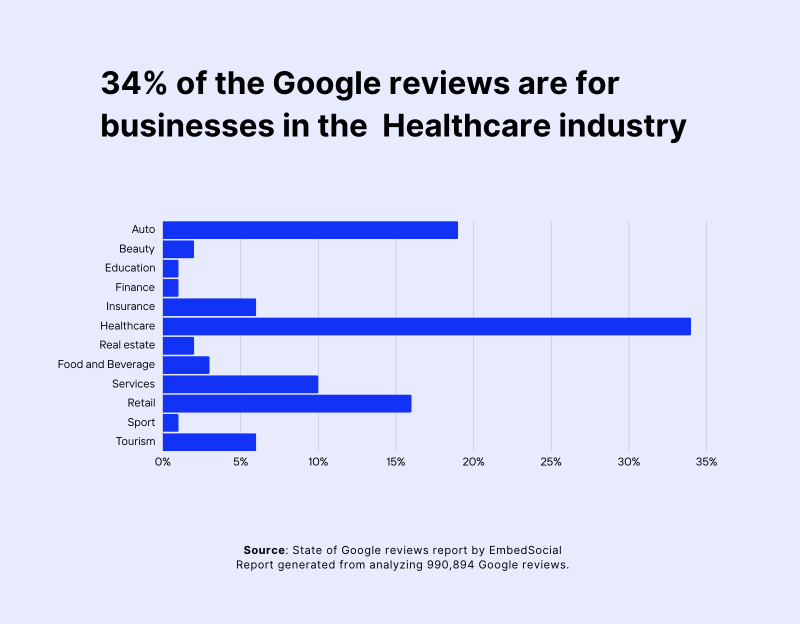
This means that out of all the reviews posted on Google, more than a third are related to healthcare providers, services, or products. This could indicate a high level of consumer engagement with healthcare services and a propensity for patients and their families to share their experiences. Given the personal and impactful nature of healthcare services, customers might be more inclined to leave reviews, whether positive or negative.
The second highest is the Automotive industry, with 19% of the reviews on Google that suggests that nearly one-fifth of all Google reviews are related to automotive businesses, such as car dealerships, repair shops, and car rental services.
7. August is the most popular month to collect Google reviews
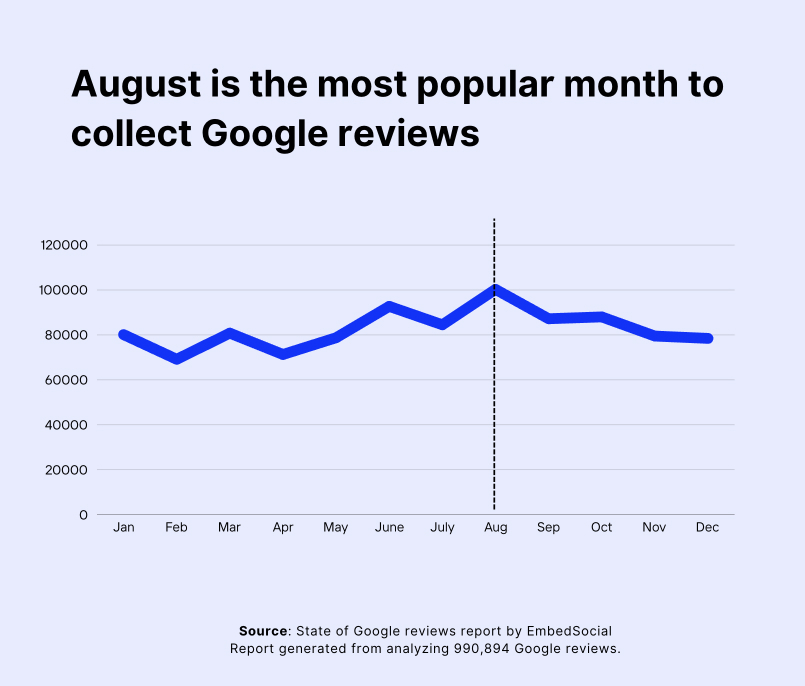
Most of the Google reviews received in 2023 were submitted in August, taking more than 10% when compared to other months, and the last month to collect reviews is February, with less than 6%.
The fact that August is the most popular month for collecting Google reviews, with a significant lead over other months, suggests a strategic opportunity for businesses. This trend could be related to seasonal behaviors, such as summer holidays, when people are more likely to travel, dine out, and engage in activities that prompt online reviews.
Businesses should leverage this peak period by encouraging reviews through targeted campaigns and promotions or by simply reminding customers of their experiences. Moreover, understanding that February sees the least number of reviews could help businesses plan their engagement strategies to boost reviews during slower months.
8. 75% of the Google reviews contain text
75% of the analyzed Google reviews have text, making the Google reviews an insightful type of review that provides the more textual context of the feedback.
With 75% of Google reviews containing text, it’s evident that the majority provide qualitative feedback rather than mere ratings. This textual context is invaluable for businesses seeking to understand customer sentiment, identify areas of improvement, and highlight strengths. It suggests that businesses should not only monitor their overall star rating but also analyze the content of reviews to extract actionable insights.
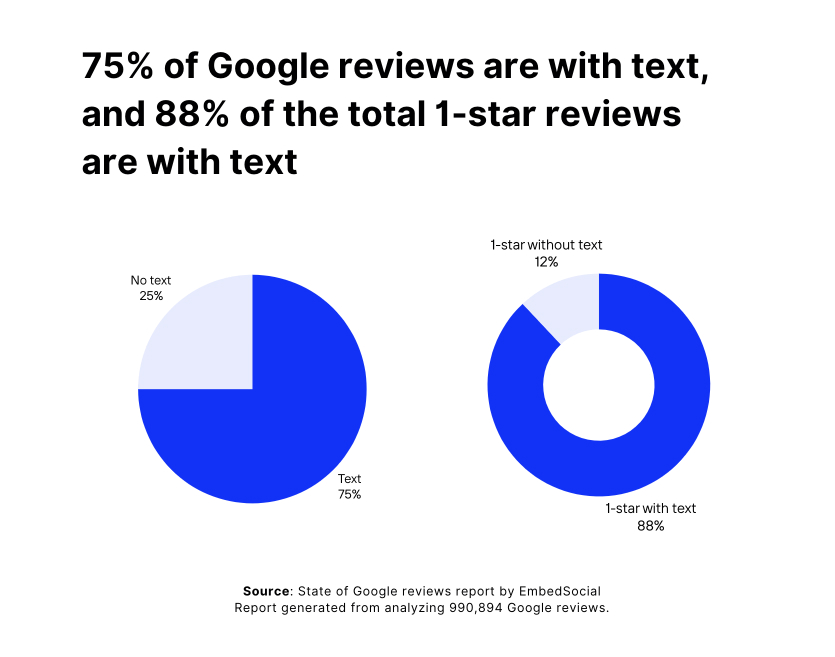
9. 88% of the 1-star reviews on Google are with text
Our research also discovered that the majority of 1-star reviews on Google have written explanations, meaning unhappy customers want to share why they’re upset.
Having text in 1-star reviews suggests that customers express dissatisfaction and are willing to detail their negative experiences. For businesses, this represents a valuable source of direct feedback that can be analyzed to identify common issues, operational weaknesses, or product flaws.
10. 86% of the Google reviews are 5 star
From the analyzed 1 million Google reviews, 86% had 5-star ratings, and only 4% (44107) had 1-star ratings.
The high percentage of 5-star reviews indicates a generally positive customer sentiment on Google. For businesses, this highlights the importance of maintaining high standards of service and quality, as customers on this platform evidently reward excellence. However, the presence of 1-star reviews, although minimal, underscores the need for businesses to address negative feedback constructively.
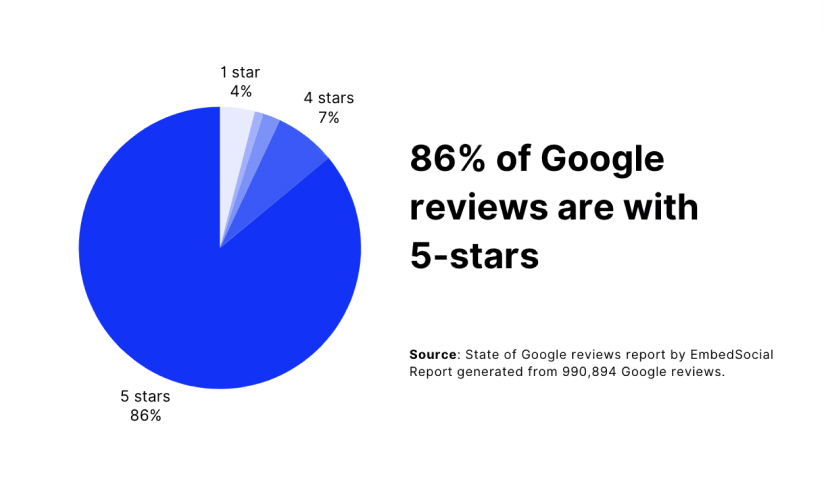
11. 69% of customers leave a Google review after being prompted
Statistics from 2023 and 2024 show that 69% of modern consumers leave reviews if they are prompted by brands. Additionally, 19% of all respondees said they always leave a review for an online business, regardless of whether they are prompted or not.
This statistic underscores the need for local businesses to implement a review collection process and even directly contact their buyers as they will most likely get a review. Plus, they’ll get a chance to establish a connection with customers and listen to their needs.
Further reading:
12. Most consumers expect a business to have between 20-99 reviews (59%)
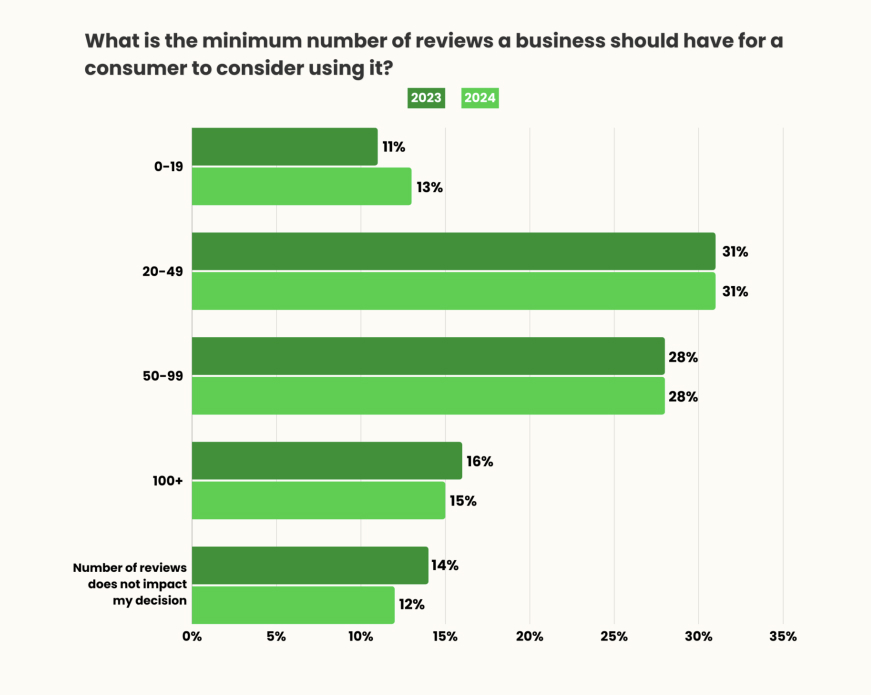
The statistic that most consumers (59%) expect a business to have between 20-99 reviews highlights the importance of not just the presence of reviews but also their volume.
This expectation can shape how businesses approach collecting and showcasing UGC, including reviews.
13. Four stars is the minimum rating you should maintain to sell nowadays
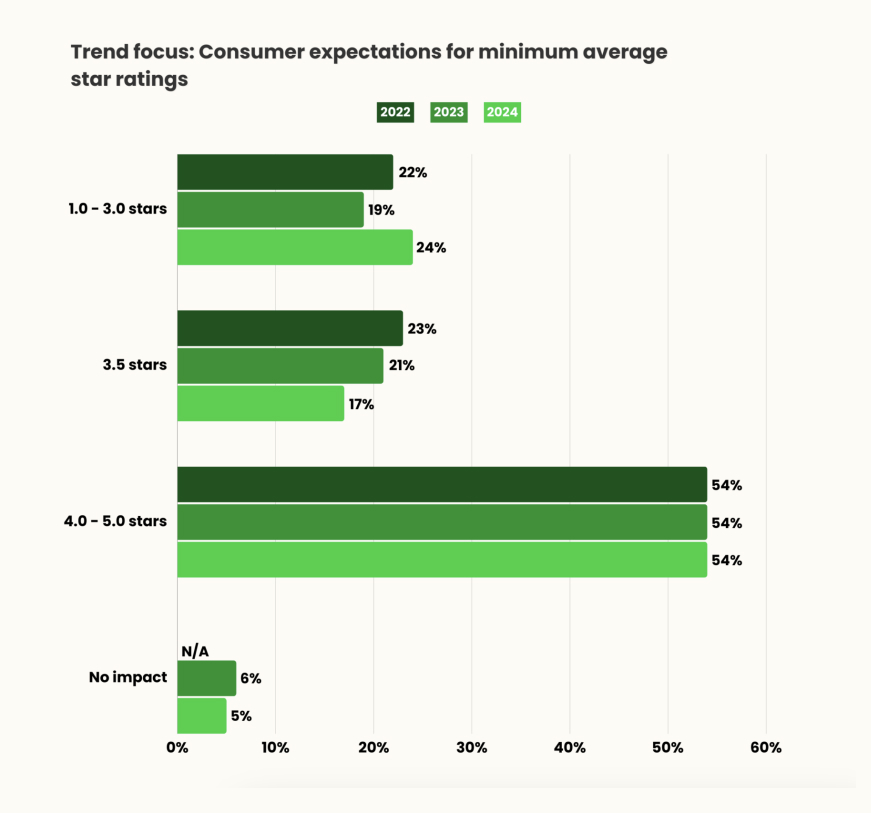
According to the same report, only 24% of consumers claim they will consider doing business with a certain brand if its star rating is as low as three stars.
This percentage jumps to 54% for a business with an average star rating of 4.
As evident from these numbers, every modern business should maintain at least a 4-star rating on their Google Business Profile if they want to have a steady customer base.
14. Top 10 businesses that receive Google reviews the most
Hair salons lead the list, holding 11.68% of the share. This indicates a high level of customer interaction and the personal nature of the service, prompting clients to share their experiences.
Next are X-ray Labs, making up 10.78% of the total. X-ray labs’ technical and essential health service may drive the volume of reviews, reflecting patient experiences and satisfaction.
Third are appliance stores, accounting for 10.72%. The involvement of significant purchases and the impact on daily life likely encourage customers to leave feedback.
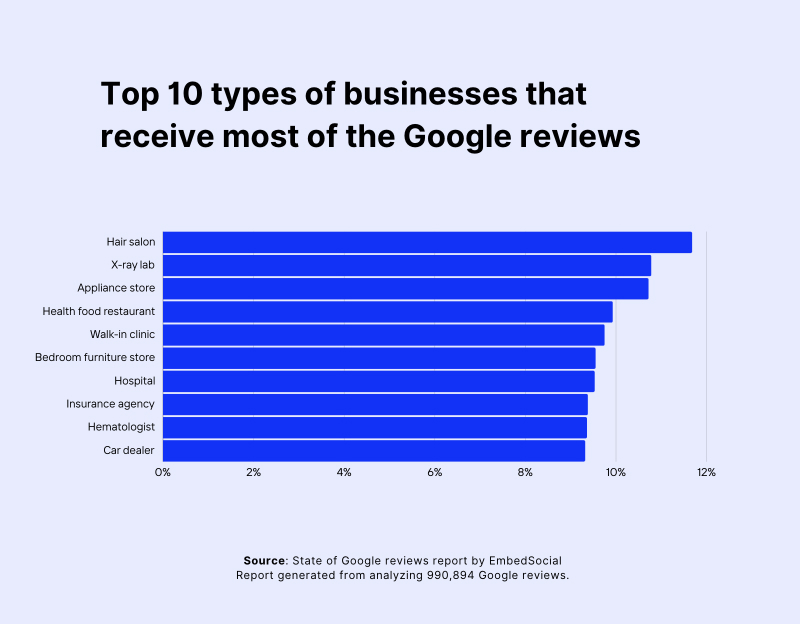
15: Displaying Reviews Can Increase Conversion by 270%
It is obvious that embedding Google reviews or other online review sites on your website will increase trust and somewhat impact conversion. But the level of the impact can be surprising.
Based on data from Spigiel from a high-end gift retailer, we found that conversion rates escalate rapidly as products begin displaying reviews.
The purchase likelihood for a product with five reviews is 270% greater than for a product with no reviews.
This research found that as products begin displaying reviews, conversion rates escalate. Having five reviews increases the likelihood of making purchase decisions by a factor of nearly 4x.
How to start getting more Google reviews?
Getting Google reviews is straightforward if you follow a few sound practices:
- Create a Google Business Profile—make sure your business is listed so customers can review it.
- Fill out your profile—add details like your hours and photos to make your profile complete.
- Ask customers for reviews—after they buy something, ask your customers to write a review.
- There are various ways to get Google reviews both in person and online, such as via QR codes, by mail, SMS, or phone, via a Google review badge, etc.
- Make reviewing easy—you must provide customers with an easy and quick method to leave reviews that won’t take more than a few minutes off their day.
- Reply to reviews—you should try to respond to every Google review you receive, especially the negative reviews, as that’s the best way to build a relationship with your customers, enhance your brand trust, and turn dissatisfied customers into loyal followers.
Once you start getting Google reviews, it’s time to start managing them.
How to continue managing Google reviews?
Managing Google reviews is key to keeping your business’s online reputation strong, and there are a few phases in this process:
- Phase 1: Collecting more reviews—we’ve already covered this process above; namely, you have to utilize every channel you have to get as many reviews as you can;
- Phase 2: Moderating your Google reviews—after obtaining your feedback, you have to moderate it into several categories as you deal with a negative review differently;
- Phase 3: Responding to your Google reviews—while responding to positive feedback reinforces your customers’ trust in you, negative reviews are an excellent opportunity to convert a bad experience into a good one for both you and your customers;
- Phase 4: Analyzing your business feedback—you learn a lot from both your bad and good reviews; while great feedback indicates that you should stay the course, a bad review reveals areas of improvement for your products and services;
- Phase 5: Displaying your online reviews—last but not least, showcasing all the great feedback you receive is a surefire way to attract new customers, and you can easily do that via a free Google reviews widget that you embed on your website!
Remember: You must stay on top of your Google reviews at all times if you want to maintain your positive brand image and attack new business!
Key Takeaways
Google reviews profoundly impact the reputation of any modern business ever since brands started establishing their online presence, and their importance has significantly grown in these post-pandemic years since the e-commerce landscape expanded greatly.
Recent Google review trends highlight an emphasis on transparency, authenticity, and the rich insights offered by user-generated content, as consumers increasingly value honest evaluations and the social proof provided by other consumers in the same situation.
For instance, unsolicited online hotel reviews make the difference when looking for a place to stay on your vacation, which is the same across the hospitality industry.
Therefore, businesses that respond to negative reviews, address concerns, and acknowledge positive reviews will build a strong online presence. So, adapting to these trends will be key for businesses aiming to thrive in today’s digital marketplace.
FYI: You can automatically embed Google reviews widget on your website and show authentic user-generated reviews, increasing trust for more sales. Try it now.
FAQs on Google review statistics
How to start getting Google reviews?
To start getting Google reviews, you must first establish your Google presence by creating a Google Business Profile and filling it out with your details. The next steps involve encouraging your customers to submit reviews and engaging with their feedback.
What are the implications of fake reviews, and how can businesses identify them?
Fake Google reviews can damage a business’s reputation, mislead customers, and impact its search rankings. They can create a false impression of a business’s quality, either positively or negatively, and erode trust among genuine customers. Businesses can spot them by looking out for spammy behavior and extreme language, and then try to have them deleted.
How can a business improve its Google review rating effectively?
To boost its Google review rating, a business should deliver outstanding service, encourage happy customers to write reviews, reply to every review, whether good or bad, act on feedback to enhance the customer experience and keep a close eye on its reviews. After all, customers read online reviews in 9 out of 10 cases when shopping online.



